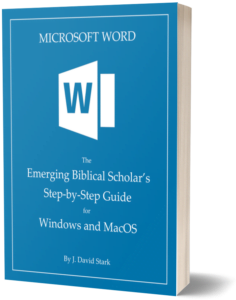Biblical scholarship begins with writing.1 Most fundamentally, that writing is the biblical text.
Almost immediately after that, however, biblical scholarship turns into writing about the biblical text and the primary and secondary literature relevant for its interpretation.
As a standard for the guild, biblical scholarship requires not just writing but digital writing. And in order to produce digital writing, you a need specific kind of tool to do the job—word processing software.
But historically, there’s been very little in the way of direct guidance about how to work with this important tool.
The Problem of How
For instance, according to the Student Supplement for The SBL Handbook of Style, you need a table of contents for documents of 15 pages or longer.2 And that table of contents is supposed to be laid out in a specific way.3
Or according to the Bulletin for Biblical Research, you can only use the “Normal” style in your article submission.4
But exactly how do you do either of these things? And how can you do them as simply as possible in order to get back to what you really care about? (After all, you probably aren’t in biblical studies because you just love formatting documents. 🙂 )
The Search for Solutions
When it comes to this question of how, that’s often where guidance is sorely lacking. Using Microsoft Word can help minimize the software challenges you face.
But even then, what’s usually been necessary has been some combination of
- Trial and error in Word,
- Searching for related advice online or general manuals,
- Not finding anything that addresses your exact question,
- Trying the best you can with the information you’ve cobbled together, and
- Still ending up with something that’s not quite what you were wanting.
Needless to say, this whole cycle can be immensely time consuming and frustrating. And the cost of this cycle rapidly mounts in terms of attention you could have spent actually writing.
You could, of course, find and hire a certified professional to give you step-by-step advice. But that gets expensive quickly too.
Step-by-Step Guidance at Your Fingertips
All of this is why I’ve written a guide specifically to address common ways emerging biblical scholars need to use Word.
This guide most directly addresses SBL style. And its principles are readily adaptable to other related style manuals as well (e.g., Chicago Manual of Style, Turabian’s Manual for Writers). There’s even a free sample.
In short, working through this guide will show you, step-by-step how to use Word and make the most out of it for your work. It will help free you to focus on the content of your writing and research.

Tired of fighting with Word? Want to be done with frustrated hours fussing over how to get the formatting you need?
My new guide shows you how to bypass all of this so you can let Word work for you while you focus on your research.

For students in any graduate program, mastering the full range of available research tools is crucial for efficient and consistent productivity. Dr. Stark has mastered these tools—the most important of which is Microsoft Word…. Students eager to take their work to the next level would do well to follow Dr. Stark’s in-depth guidance.
Header image provided by the Noun Project. ↩
Melanie Greer Nogalski et al., Student Supplement for The SBL Handbook of Style, Second Edition, ed. Joel M. LeMon and Brennan W. Breed, rev. ed. (Atlanta: SBL, 2015), §2.7. ↩
Nogalski et al., Student Supplement, §3.3. ↩
Bulletin for Biblical Research, “Submission Guidelines for Authors” (Pennsylvania State University Press, n.d.), 2. ↩

Leave a Reply